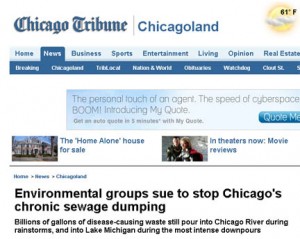The Chicago Tribune and many other news outlets covered our recent lawsuit against the Chicago Metropolitan Water Reclamation District (MWRD) to stop the routine dumping of raw sewage and under-treated wastewater into the Chicago River and Lake Michigan. During heavy rains (anything more than 2/3 of an inch), the pipes that would normally send a combination of wastewater and stormwater to Chicago sewage treatment plants cannot cope with the sheer amount of water and sewage and instead overflow, releasing that bacteria-laden water directly into nearby waters. The regular discharge of water from these treatment plants contains too much phosphorus which causes excessive growth of algae, blocking sunlight and using up oxygen that fish and other aquatic animals need to survive. The release of raw sewage and excessive phosphorous are both in violation of the federal Clean Water Act. The MWRD has actually been under investigation by federal regulators for nearly a decade, but no action has been taken.
A draft agreement on April 21 calls for more specific deadlines to finish the Deep Tunnel project, a labyrinth of large tunnels and reservoirs underground that serve as a holding area for excess water. The MWRD would also pay $670,000 in fines and spend $325,000 on “green infrastructure” that allows rainwater to better absorb into the ground rather than running off into sewers. This pales in comparison to the city of Cleveland, OH, which recently agreed to spend $42 million on green infrastructure and pay fines of $1.2 million.
The lawsuit was brought by Prairie Rivers Network, the Sierra Club, and the Natural Resources Defense Council (NRDC). Read the Chicago Tribune article here.
See these additional resources about reducing stormwater pollution:
Prairie Rivers Network’s Stormwater Management Guidebook, a guide to green infrastructure with examples throughout Illinois.
Rooftops to Rivers and Re-Envisioning the Chicago River (published by the Natural Resources Defense Council). The first is a guide to green strategies for controlling stormwater and combined sewer overflows, and the second includes the benefits of green infrastructure specifically for the Chicago region, with a summary of how everything relates to invasive species such as the Asian Carp.
The lawsuit was also covered in these news outlets:
The Pantagraph (Bloomington-Normal)
Park Forest ENews (Chicago area)








